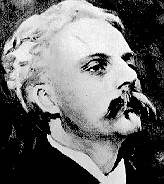| B i o g r a p h y |
 Gabriel-Urbian Fauré
was born May 12, 1845, in Pamires, Mid-Pyrenees, France. He was the
youngest of 6 children born to Toussaint and Marie Faure. From the age
of 9 he studied piano and organ with Camille Saint-Saëns at the
Ecole Niedermeyer. Saint-Saene encouraged young Faure to play piano
music by Franz Liszt. In 1865 Faure was awarded first prize for
composition, for his 'Cantique de Jean Racine', opus 11. In 1870 he
served in the army during the Franco-Prussian war, and during the Paris
Commune he was a music teacher in Switzerland, where his school Ecole
Niedermeyer was relocated. Back in Paris he became organist at
Saint-Sulpice.
Gabriel-Urbian Fauré
was born May 12, 1845, in Pamires, Mid-Pyrenees, France. He was the
youngest of 6 children born to Toussaint and Marie Faure. From the age
of 9 he studied piano and organ with Camille Saint-Saëns at the
Ecole Niedermeyer. Saint-Saene encouraged young Faure to play piano
music by Franz Liszt. In 1865 Faure was awarded first prize for
composition, for his 'Cantique de Jean Racine', opus 11. In 1870 he
served in the army during the Franco-Prussian war, and during the Paris
Commune he was a music teacher in Switzerland, where his school Ecole
Niedermeyer was relocated. Back in Paris he became organist at
Saint-Sulpice.
Faure became a regular at the salon of Camille Saint-Saëns and
the salon of Pauline Garcia-Viardot. There he met many prominent
Parisian intellectuals: writers Gustave Flaubert and Ivan Turgenev,
composers Hector Berlioz and Georges Bizet. With those contacts Faure
initiated the formation of the 'Societe Nationale Musique' around the
figure of Camille Saint-Saëns. Faure also took over the position
of organist at the Eglise de la Madeleine in 1877, when Saint-Saens
retired. At that time Faure became engaged to Marianne Viardot, the
daughter of Pauline Viardot, but the engagement was broken off by
Marianne.
Faure was sincerely in love, but heartbroken and so depressed, that
he could not stay in the same salon. He canceled all social obligations
and left Paris for a long journey. He went to Weimar, where he met
Franz Liszt and expressed his gratitude by playing his own compositions
to Liszt. Then Faure traveled to Cologne to listen to the operas of
Richard Wagner, whom he admired. Faure's impressions from 'Der Ring des
Nibelungen' were strong, but not enough to influence his own
compositions.
Back in Paris he renewed his activity at 'Societe Nationale
Musique'. He married Marie Frement in 1883, and the couple had two
sons. He had to support his family. The lack of any musical success
kept him working as the organist at the Eglise de la Madeleine, and
also teaching piano and harmony, which took up all his time. His own
compositions were sold to his publisher at 50 francs per piece with thw
copyright. At that time Faure composed the exquisitely delicate
'Requiem' (1888), his most important choral work. He could not find a
venue to perform his large-scale compositions. That made him even more
depressed.
After ten years of hardship, Faure finally got promoted to the
government position of the Inspector of Music Conservatoires in the
French provinces. In 1896 he became chief organist at the Eglise de la
Madeleine. He also replaced Jules Massenet as professor of composition
at the Conservatoire de Paris. His students there included Maurice
Ravel, Nadia Boulanger, Georges Enesco, and Charles Koechlin, who later
orchestrated Faure's popular suite 'Pelleas et Melisande'. In 1890s
Faure wrote piano duet 'Dolly Suite' and a vocal piece 'La bonne
chanson' for Emma Bardac, the wife of Claude Debussy.
From 1905 to 1920 Faure was the powerful director of the Conservatoire de Paris. He made some reforms and dismissed unnecessary stuff for the purpose of rational spending of the funding from the government. His song opera 'Penelope' (1913) is noteworthy. His works of the late years were affected by his hearing loss, which inevitably caused his retirement. He was the music critic at Le Figaro from 1903-1921. Faure died from pneumonia on November 4, 1924, and was laid to rest in the Cemetiere de Passy in Paris.